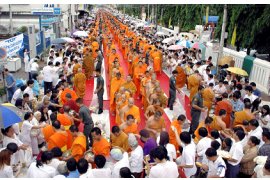KHMER, NORTHERN [KXM] 1,000,000 (1991 SIL). Northeastern Thailand, mainly Surin, Sisaket, Buriram, Korat Provinces. Austro-Asiatic, Mon-Khmer, Eastern Mon-Khmer, Khmer. Dialects: BURIRAM, SURIN, SISAKET. Different from Central Khmer. Dialects are intelligible with each other. 50% to 75% literate. Typology: SVO; prepositions; genitives, modifiers, relatives after noun heads; 1 prefix; CV, CVC, CCV; non-tonal. Scrub forest. Plains. Peasant and intensive agriculturalists, craftsmen, educators, officials. Altitude: 500 meters. Buddhist, Christian. NT in press (1996).
Standard Thai in a formal education setting: A case study in Buriram, Thailand
Worawan Hemchayart, University of Nebraska - Lincoln
Date: 1998
» Download the dissertation (PDF format)
» Tell a colleague about it.
» Printing Tips: Select "print as image" in the Acrobat print dialog if you have trouble printing.
» Off-Campus UNL Users - Click here to log in to our proxy server for access to this dissertation. After logging in, click "Download the dissertation" above.
Abstract
The purpose of this study was to investigate, 'How students, whose first language is denied in a formal education setting, adjust to learning Standard Thai?' The Benjakam-Wittayalai Elementary School is located in the Muang District of Buriram, Thailand. The school population consisted of 470 students and 18 teachers, about 90% of whose local population are North-Khmer speakers. These students spent seven hours a day emerged in a Standard Thai language classroom. Their first language is a dialect of Thai.
There were seven groups of selected participants. How these participants shared their personal language experiences in the use of both languages, and what difficulties they encountered in adjusting to learning Standard Thai in a school was investigated. Multiple data collection sources were used. A bilingual research assistant was employed to aid in the study. All data were transcribed by the researcher. The responses were coded into the following five themes which emerged during the analysis process: (1) Standard Thai is regarded as a measurement of student success and status both academically and personally. (2) Both the schools and the students have significant financial problems impeding the learning of Standard Thai. (3) Attitudes and values exist toward the use of both languages inside and outside the school that affect student expectations and language performance. (4) Respect and reverence for the local culture contributed to resistance in acquiring Standard Thai. (5) The impact of learning Standard Thai on the relationships among teachers, students, and family members in both the schools and home environments varied.
The question of dialect education was investigated. Academic instruction should continue to be in Standard Thai, but special attention should be provided to help the students optimally learn Thai as their second language, rather than learn Thai as the native language. The purpose for the introduction of Standard Thai into the schools was to help the students enter the formal education system, and to adjust to learning Standard Thai with a sense of national and regional pride in their spoken language.



 พระ
พระ












